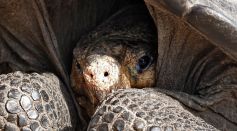Tags: Giant Tortoise

Living Galapagos Giant Tortoise Discovered for the First Time After 100 Years of Being ‘Extinct’

Never Before Seen Giant Tortoise, Over 8,000 Lineage Discovered in Galapagos

Meet 190-Year-Old Jonathan the Oldest Living Tortoise and Other Old Land Animals on the Planet
Tortoise Diet: Watch How This Giant Reptile Goes in for the Kill for Its Not-so-Usual Meal

Turtles Can Live From the Victorian Era up to Present; Reason Behind the Longevity of Turtles Explained
Scientists Look Into Impacts of Mismatched Migration Route on Tortoises
How One Endangered Species Is Making A Change For the Better—Eating Sweeter Flora Instead
The Energy for a New Crawl—Galápagos Tortoises Feast on Invasive Plants for a New Foraging Technique
Giant Tortoise Babies Born in the Wild for the First Time in 100 Years
Most Popular

Will Earth's Magnetic Poles Flip Next? Magnetic Pole Reversal Explained Through Cutting‑Edge Magnetosphere Science

Relativity Time Dilation Explained: The Physics of Time and Why It Moves Differently in Space

How Lightning Science Reveals Why Charged Storms Are Rising with Global Warming Effects

How AI Is Used in Weather Prediction: Smarter Forecasting Through Machine Learning





